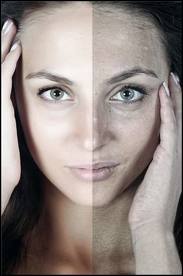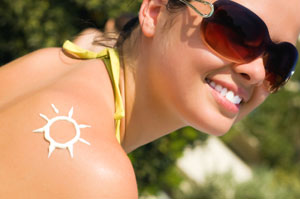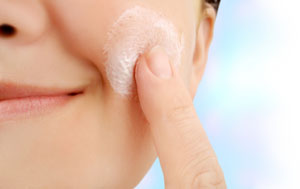While sun damage doesn’t happen overnight, it can seem like it visibly affects the skin in a rather short period of time. The more the skin is exposed to the sun, the more the collagen and elastin in the deeper layers is broken down, giving less support to the underlying muscles and the skin’s surface. As a response mechanism, the skin tries to protect itself from the damage, in turn thickening as a means of regeneration.

Treat sun-damaged skin at home:
Peptides and vitamin A need to be used consistently to help strengthen the skin and improve its texture. Retinol is key since it sheds the top layer of skin and strengthens it from inside out. Use a Retinol regularly, because it keeps the skin in repair mode, creating new collagen and exfoliating the surface.
Free radical-fighting ingredients like green tea and vitamins C and E will help safeguard the skin from future damage.
Protection and maintenance are vital-once sun-damaged skin has been transformed, you don’t want it to regress. It is recommended to wear a sunscreen with ingredients that contain either physical or chemical blockers and broad-spectrum products, which provide protection from all UV rays. Also use antioxidants and a moisturizer.

Treat sun-damaged skin professionally:
Laser and light-based treatments, like Intense Pulsed Light (IPL) and both ablative and nonablative resurfacing procedures, work to reinstate the skin. IPL can help eliminate brown and red spots on the face and body. A downtime-free treatment, although several sessions are required, IPL helps to rejuvenate the skin so that it looks younger and fresher.
Treatments that tackle sun-damaged skin, including chemical peels, can improve the skin, too. But, if not done properly, they can cause more harm than good. Acid-based peels buffer the skin, making it more sensitive to the sun.
Fractional lasers, like Fraxel, get rid of discoloration while improving the skin’s texture. Instead of employing light, fractional resurfacing lasers create microscopic wounds in the skin-as the skin heals, the sun-damaged areas scab and flake off, and collagen is purportedly increased.
Interval treatments will be needed over time, because nothing lasts forever- not even the results of lasers. Re-treatments every now and then will help maintain the longevity of your results for healthier skin. Please call our office at (817) 473-2120 for more information and questions on laser treatments and skin care. You can also visit our website at www.MarkBisharaMD.com. Dr. Bishara and The Paragon Med Spa provide a wide range of cosmetic procedures to help patients look and feel their best.

While some learn to love those tiny brown spots on the tip of the nose, cheeks and shoulders, others look for anything to fade freckled skin. Thankfully, you can lighten unwanted freckles and spots instead of just covering them up with makeup. And, obtaining brighter, smoother, spot-free skin may be easier than you think. At the office of Dr. Mark Bishara we want to educate our patients about proper skin care and help them improve the health and appearance of their skin.
Protect and Prevent
With a medical name like ephelides, it’s no surprise that freckles get a bad rap. While “simple freckles,” the tiny brown spots on your skin you have had since birth, are harmless, lentigines, or “sunburn freckles,” need to be taken more seriously. Usually larger in size, more red in color and with an irregular border, these spots are sure signs of sun damage. No matter how old you were when you first noticed your freckles, sun exposure can only make them darker and greater in number. The easiest way to prevent freckles from forming is by using sunscreen. “I recommend applying sunscreen with at least an SPF of 30,” says New York and Miami dermatologist Fredric S. Brandt, MD. “No product will effectively lighten skin without the use of sunscreen on a daily basis.”

On the Bright Side
Over-the-counter brighteners can help to even out freckles and spots for more evenly toned skin. The SkinCeuticals line of skin care products offers 3 different product categories to: Prevent, Protect and Correct. Many of their products help to reduce the appearance of spots, leaving the skin looking luminous and glowing. For more information on the SkinCeuticals products and to find out the right skin care regimen for your skin type and skin condition please visit their website at www.SkinCeuticals.com. Our office offers the SkinCeuticals skin care line and can also help you choose the right product for you.
Zap Away
For serious long-term freckle fading, laser resurfacing lightens and retexturizes. Unlike chemical peels and microdermabrasion, which just exfoliate, pigment-specific lasers, like the Alma laser systems, specifically destroy pigment in the epidermis and dermis to eliminate discoloration with minimal side effects. Fractional resurfacing lasers poke tiny holes into the skin to deliver a dose of controlled heat to the deeper layers, eliminating freckles from the inside out. Not a laser, but similar in terms of results, Intense Pulsed Light (IPL) uses broadband light to diminish freckles. Not all lasers are alike, so it’s important to diagnose your skin accurately prior to treatment.
Please visit our website at www.MarkBisharaMD.com or call us at (817) 473-2120 for more information.

As winter is upon us, you have probably noticed that you skin is getting dryer. This is common and we see changes in our skin throughout the seasons of the year. And, your skin will require different care and treatment depending upon the season of the year. So what should you be doing differently? Glad you asked.
With the cold, you skin needs better protection. And many times this means preserving the natural oils that protect our skin, or adding to them. So, here are some tips for you.
Ease up exfoliants
Many cleansers and other skin care products we use contain chemicals such as the alpha hydroxyl acids (think glycolic acid) which will help with exfoliation or skin cell turn over. These are great for making your skin look fresher, but they also can dry out your skin. So, you may want to tone it down during the winter months. If there is a product like this that you use every day, back off to using it every other day, or once or twice a week.
You may also need to change your facial cleanser, or change other products. Since you skin’s needs are different with the seasons, you may need to change your products with the seasons as well. Consider moving from your glycolic cleanser to a gentler one, or one which also moisturizes or hydrates. Or add a hydrating product to your antioxidant products. And play around with things. If you head to Colorado to ski, know that it may be colder and more arid than you home. So, alter your skin care plan as you need to.
Moisturize, Moisturize, Moisturize
You really need to moisturize, but then I may already have said this. And, everyone will tell you that it is best to apply our moisturizer while your skin is still a little damp. This applies to your face, your hands, and the rest of your body. In addition to keeping in your body’s own oils, the moisturizer will also help to protect you skin as a barrier to the cold.
The hands actually take a bigger hit with the cold than anywhere else on your body. So, keep a good hand moisturizer around and use if often, especially if you wash your hands a lot during the days. And gloves. When it’s cold outside, be nice your hands and protect them from the wind and cold.
Long hot shower are not good for you
When you’ve been outside and need to warm up, many of use hop in the shower and turn up the heat. We may even stay there until the hot water heater gives out. But, this is not good for us. The hotter the water, the more it removes you skin natural oils and barriers. And, the longer you are in the shower, the more this happens. So, go with warm water not scalding hot. And leave some hot water for everyone else in the house!
Give you skin a treat
While long hot showers are out, a soak in a warm tub can be great especially if you add something to the bath water. If you have a lot of irritation, try an oatmeal bath. Baking soda can also work. And if you are looking for some added moisture, add a couple tablespoons of olive oil. You can even use olive oil and oatmeal together (but I would leave out the balsamic vinegar…just saying).
Continue to protect
You still need your sunscreen! Even though the days are shorter and we are all looking for sun to cure our affective seasonal disorder, those beneficial rays can still burn. So continue to use your sunscreen. One of the easiest ways to do this is to use a skin care product, or makeup with sunscreen in it. And, if you heading up to the mountains to ski, or down to the Caribbean to escape the cold, get some high test sun screen, and reapply it often.
It doesn’t take too much to take care of your skin during the winter, but a little goes a long way. Just remember that your body’s natural oils are your friend, and what you do for your skin in the summer is not what your skin will need in the winter.

At Dr. Mark Bishara’s office we help educate our patients about proper skin care. We have many laser procedures that help revitalize and rejuvenate your skin. We also have an extensive line of SkinCeuticals products and our aestheticians can help tell you which products will prevent, protect and correct any skins damage. Please call our office for more information at (817) 473-2120 or visit our website at www.MarkBisharaMD.com.
Aside from being the largest organ of the human body, skin is also the only organ continually exposed to the surrounding world, interacting with the environment and reflecting the general health condition and age changes.
How Skin Ages
Understanding the mechanisms by which the skin ages has been increasing significantly, along with considerable progress on the way to prevent and reverse the visible signs of aging. However, there are still several mysterious factors concerning aging process and why we all appear to age differently. Aging of the skin is likely caused by both intrinsic (biologic) ‘intrinsic aging’, and extrinsic aging (environmental) factors ‘extrinsic or photoaging‘; these factors are interconnected and may share a final common pathway. The quality of skin features is greatly affected by aging, as skin ages, it tends to become roughened, lax and wrinkled with some pigmentary changes.
The main feature of photodamaged skin is solar elastosis; with accumulation of elastotic material in the dermis. Meanwhile, photoaged skin shows gradual decrease in collagen content. Additionally, collagen becomes disordered with decreased synthesis and enhanced breakdown. These changes contribute to the skin laxity and wrinkling formation.
Skin Rejuvenation
Besides being an art, facial rejuvenation is a developing science. Patients now routinely present to their physician requesting information on improving the signs of facial aging; it is the physician’s responsibility to select the most appropriate intervention(s) based on the patient’s age, physical needs and concerns, extent and location of volume loss and cosmetic goals. Different therapeutic approaches were used throughout the years to give the face a youthful appearance. However, because each person is unique, there is no one modality that is best for everyone. Therefore, to choose the most appropriate therapy, distinctions must be done between rhytides caused by loss of collagen within the dermis, wrinkles due to volumetric loss of fat, redundant folds created by gravitational pull and those caused by hyperfunctional facial muscles.
For ease of patient education, the treatment options for addressing these changes may be simplified into five categories, often referred to as the ‘5 Rs (Redraping, Resurfacing, Retaining, Relaxing and Refilling) of skin rejuvenation: surgically Redraping and lifting redundant tissue; Resurfacing photoaged skin with ablative or non-ablative technologies whether physical, chemical or mechanical; Retaining with skin care; Relaxing dynamic rhytides that are due to hyperfunctional muscles with neurotoxins and Refilling of diminished subcutaneous tissue by restoring 3D volume.
Ablative and Non-Ablative Procedures
Although ablative modalities remain the gold principle for photodamaged skin rejuvenation, its use is associated with risk of side effects as well as a prolonged and an unpleasant post-treatment ‘downtime’ and recovery period. Thus, interest in ablative treatment has waned considerably while non-ablative modalities as well as fractional skin rejuvenation have become appealing alternative treatments.
New perspectives in non-ablative skin rejuvenation treatments have been established with the development of new technologies and techniques, which are used to rejuvenate skin with minimal downtime and complications. Many different terms have been used to describe these procedures including: subsurface resurfacing, laser toning and minimally invasive skin rejuvenation. These modalities are designed to produce many cosmetic benefits, including improvement of wrinkles, skin laxity and texture.
Beside lasers and various in-office procedures, many topical skin care agents were used for prophylaxis as sun screens and for rejuvenation such as retinoic acid and different anti-oxidants including vitamins C and E, co-enzyme Q10 and green tea.
Choosing the appropriate treatment modality which will be the key to success in skin rejuvenation depends on careful evaluation and determining the patient’s needs, skin type and condition, to frame a treatment plan. Good candidates for minimally invasivetechniques tend to have minimal facial sagging. Patients should understand that skin texture will improve and fine lines will be softened but not eradicated. Cumulative aesthetic benefits will occur gradually and will be less dramatic than those seen with ablative resurfacing. Patients with Fitzpatrick skin type III or less are generally best candidates for different procedures with minimal risk of complications.
Goals of Minimally Invasive Treatments
The goal of most minimally invasive treatments is to induce selective dermal injury which results in wound repair response; while keeping the overlying epidermis intact. In response to the induced dermal injury, the healing process begins to stimulate the fibroblast with deposition and reorientation of collagen bundles. Such modalities for skin rejuvenation could be classified into two types, the first relates to treatment of ectatic vessels, pigmentation and pilosebaceous changes, while the second refers to dermal remodeling with wrinkle reduction and/or skin tightening.
Dr. Mark Bishara, whith office in Mansfield and Southlake, TX- provides a wide range of cosmetic procedures to help patients look and feel their best. These procedures are designed to improve the appearance of the face and body through minimally invasive techniques that provide highly effective results. Many of these procedures can be combined in order to achieve your desired appearance. All of our procedures are performed using the most advanced, state-of-the-art equipment.
At our office we offer many treatments that are ablative as well as non-ablative. Our Pragon Med Spa offers many laser services- skin tightening, skin resurfacing, as well as peels and microdermarbrasion. Our office also offers Botox, Juvederm and Radiesse. The new Juvederm Voluma XC will be coming soon. Please call our office for more information at (817) 473-2120.
Skin experts say that the best way to keep your skin healthy and looking young is to protect it from the sun and not smoke: and after that, taking care with how you wash, moisturize your skin and shave also help.
According to a British Association of Dermatologists survey carried out last year, many Britons are unaware that sun protection can keep the skin looking younger, believing instead that applying a daily moisturizer, eating a healthy diet, drinking plenty of water and having facial massages will suffice.Not only does exposure to UV increase a person’s risk of skin cancer, it also affects the elastin in the skin, which leads to wrinkles and sun-induced skin ageing such as leatheriness and blotchy pigmentation. Featured below are 5 tips for healthy skin:
Tip #1 for healthy skin: Sun protection

Ensure you protect your skin from the sun to maintain healthy skin
Most of the changes seen in ageing skin are actually “caused by a lifetime of sun exposure”.
To protect yourself from the sun, they advise the following three methods (with maximum protection coming from using all three).
- Avoid the sun during high intensity hours: the sun’s rays do the most damage between 10 am and 4 pm, so limit the time you spend outside during this period.
- Wear protective clothing: wear long sleeved shirts, long trousers or pants and a hat with a wide brim. Remember that tight woven fabric (eg denim) offers better protection than loosely woven fabrics like knits.
- Use sunscreen: go for a broad spectrum sunscreen with an SPF (sun protection factor) higher than 15 and apply generously about 20 minutes before you go out and then every two hours. You will need to apply more frequently if you go in the water or sweat a lot.
Tip #2 for healthy skin: Don’t smoke (and watch the alcohol)
Research shows that smoking alone ages skin. In a study published in the Archives of Dermatology, researchers described how they examined the upper inner arms of smokers and non-smokers aged from 22 to 91 and found that after taking into account age and other variables, the number of packs of cigarettes that the smokers smoked per day was significantly linked to skin ageing. They looked at the skin on the upper inner arms to minimize the influence of sun exposure.
Smoking reduces the skin’s natural elasticity by promoting the breakdown of collagen and also reducing the amount that is produced.
Collagen, a protein that helps skin strength, gradually degrades with age, leading to wrinkles. Smoking causes this to happen sooner and also causes the tiny blood vessels in the skin to tighten, which reduces the amount of oxygen and nutrients that the skin cells receive, which also reduces elasticity and accelerates ageing.
The Mayo Clinic also suggest that exposure to heat from burning cigarettes damages facial skin and that certain smoking behaviours contribute to wrinkles, because of the repetitive facial expressions that smokers make, such as pursing the lips on inhaling and squinting their eyes to keep the smoke out.
Drinking alcohol can make your body and skin dehydrated, leaving the skin looking old and tired. So if you are drinking alcohol drink plenty of water and stick to sensible amounts. Have a non-alcoholic drink like soda water or watery fruit juice in between the alcoholic ones to help your body rehydrate.
Tip #3 for healthy skin: Clean your skin regularly and apply moisturizer
A British Skin Foundation survey published in January 2008 found that an astonishing 50 per cent of people who wear make up in the UK are damaging their skin by not removing make up before they go to bed.
The reasons for not cleansing the skin of make up before going to bed were also revealing in that most people were too tired to take it off, suggesting they were not getting good quality sleep which also affects skin health. A significant proportion also said they had had too much to drink or simply couldn’t be bothered.
Cleansing is an important part of skin care because it removes dirt and bacteria; and the key is to do it gently.
Use warm rather than hot water and limit the time you spend in the bath or shower to 15 minutes or less as too much time in hot water strips oils from your skin.

Moisturizing protects the skin from drying and acts as a protective layer for the skin
Also, use mild rather than strong soaps and avoid irritating additives such as perfumes and dyes, especially if you have sensitive skin.
When removing make up take care with the delicate skin around the eyes, and if you use waterproof make up you may need an oil-based product to make sure you get it all off.
When you have finished try to pat your skin dry so some moisture stays on it.
Moisturizing is important because it protects the skin from the weather and from drying up and looking dull. It helps your skin maintain its natural moisture levels too, say the Mayo Clinic experts, because it seals in the water already in the skin or slowly release water into the skin.
If you have dry skin avoid alcohol-based products and if you have oily skin avoid oil-based products (use water-based instead).
Some people with oily skin don’t need moisturizer: if your skin feels tight 20 minutes after bathing, then you probably do.
Tip #4 for healthy skin: Get enough quality sleep

Focus on quality sleep to keep your skin looking young and healthy
Sleep is essential for healthy skin. Not enough quality sleep will make your skin look tired and older, especially with bags under your eyes. Poor quality sleep can become a vicious cycle because lack of sleep makes you irritable, anxious and depressed, and that makes it harder to get good sleep.
Make sure you have plenty of physical exercise as this reduces stress and creates a healthy tiredness that helps sleep. Yoga and swimming are also good ways to improve sleep.
Aerobic exercise increases the oxygen circulating in your body which helps the skin stay vibrant and healthy.
Tip #5 for healthy skin: Shave with care
People shave to make their skin smooth and hairless, but this can irritate the skin, especially if it is thin, dry and sensitive.
For a smooth shave the Mayo Clinic experts advise that you shave after a warm bath or shower (or press a warm wet cloth on your skin) to soften the hair, don’t shave dry skin, use a clean, sharp razor, and shave in the direction of hair growth.
Make sure you rinse well afterwards with warm water to remove soap and dead cells.
If your skin is irritated after shaving don’t use an alcohol based lotion even if it feels cool, it will make the irritation worse because it dries the skin out.
Dr. Mark Bishara and The Paragon Plastis Surgery & Med Spa in Mansfield and Southlake, TX offers minimally invasive procedures, and skin care treatments to help keep your skin looking great. These treatments are designed to provide subtle enhancements that can improve your targeted problem areas, while allowing you to return to work and your regular activities the very same day. Dr. Bishara is also proud to offer a wide range of enhancing, minimally invasive procedures such as Botox, Xeomin, Juvederm Ultra Plus XC and Radiesse. Juvederm Voluma XC will be available soon. We will keep you updated or call our office for more information at (817) 473-2120.



